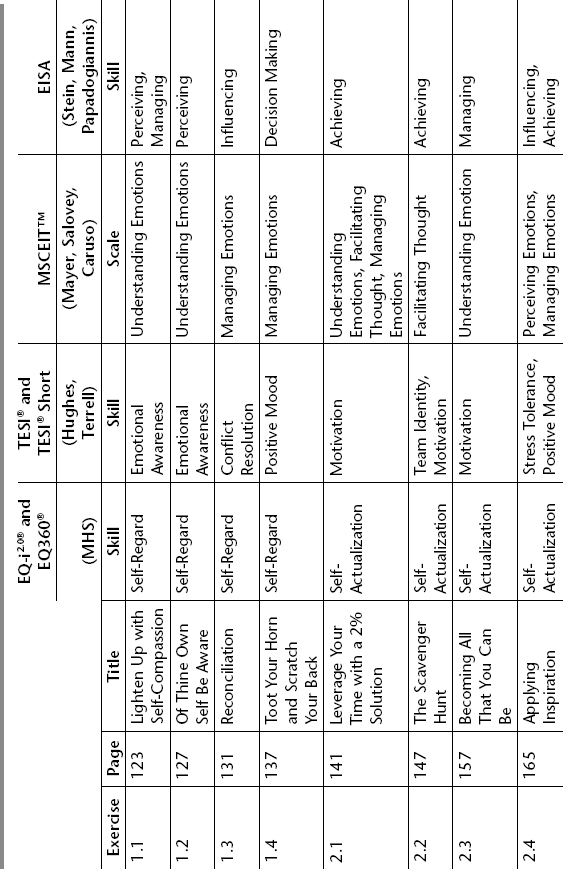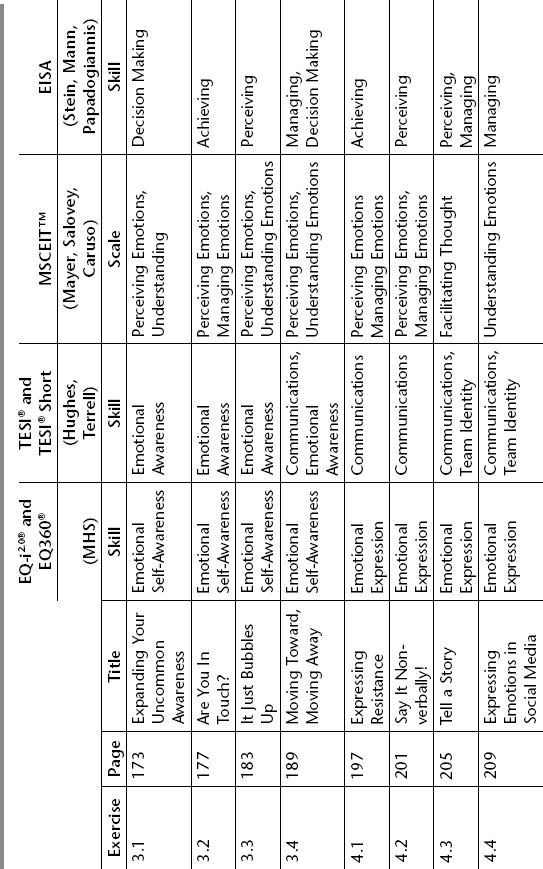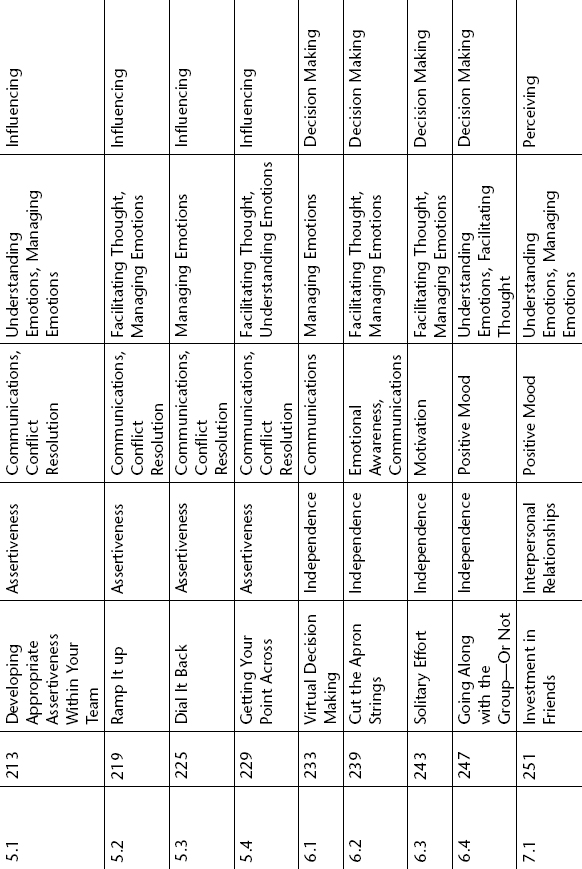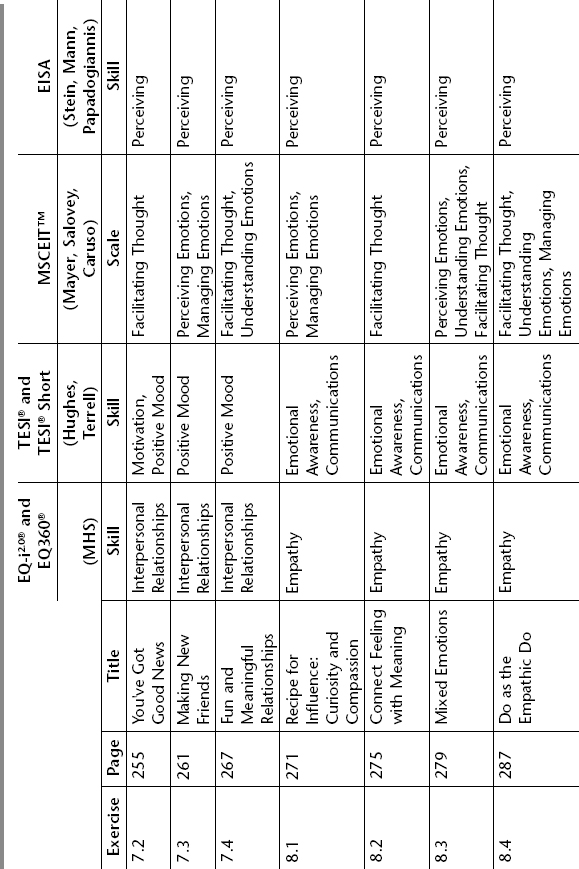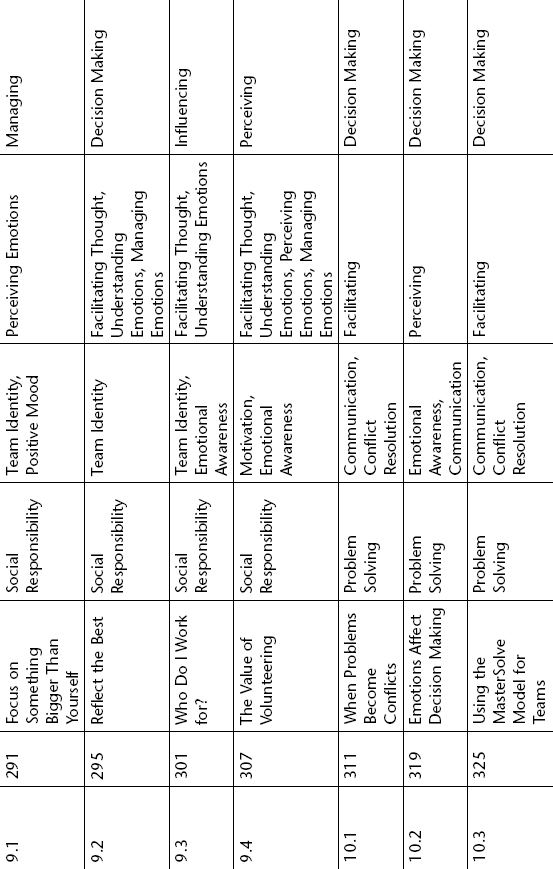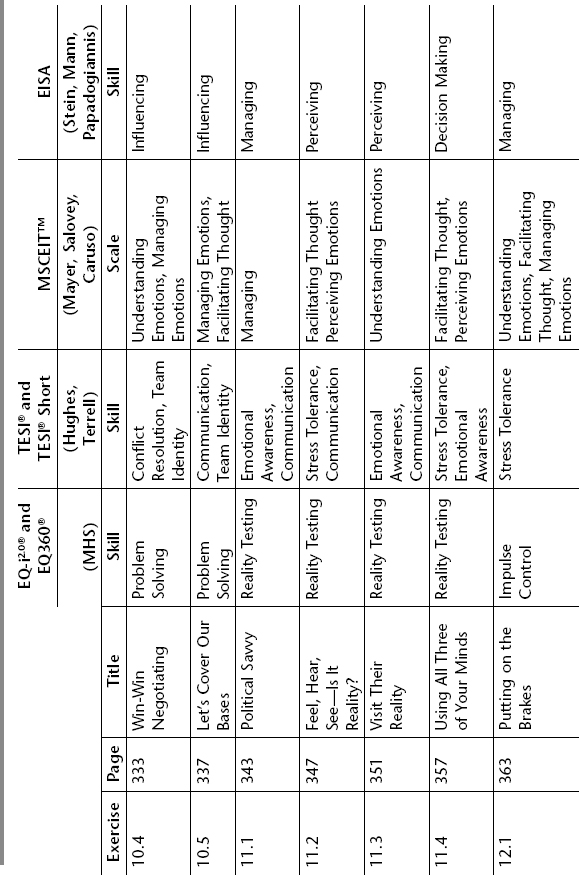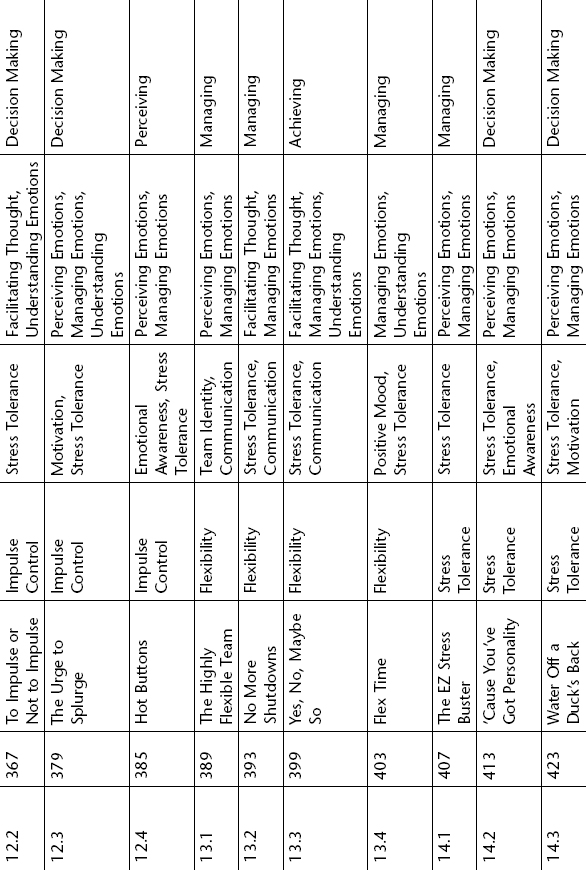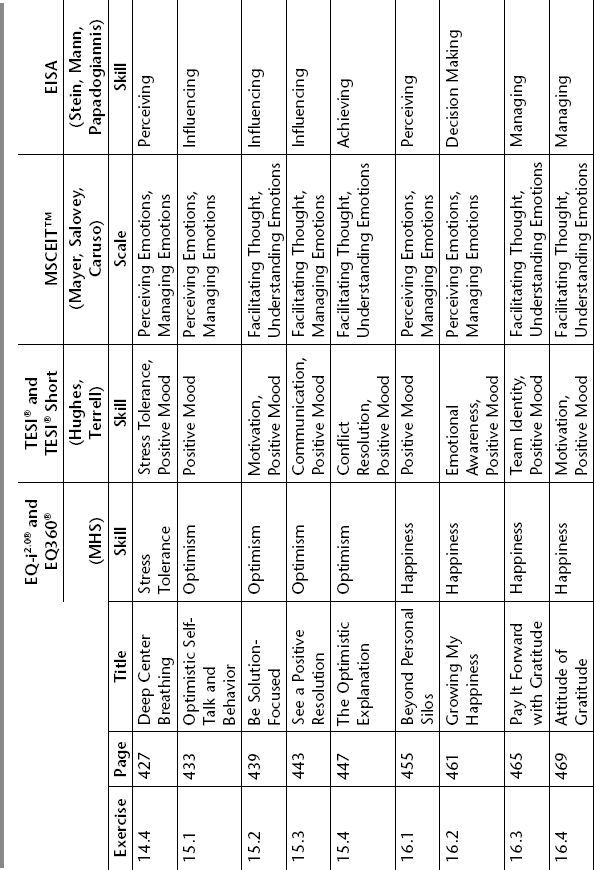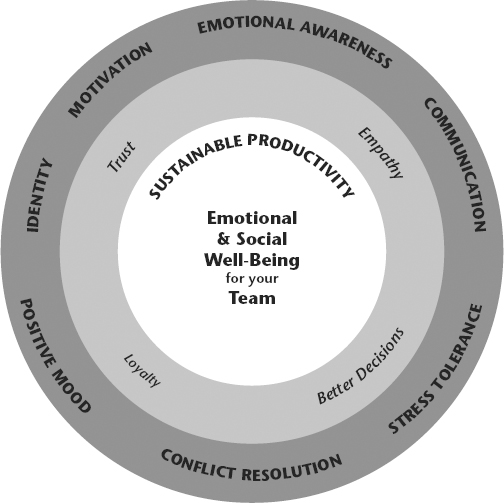CHAPTER 2
How Everyone Can Use the Exercises
Cross-Reference Matrix
Emotional intelligence is well established as a critical aspect of successful leadership. The greater the leadership responsibility, the more important our emotional intelligence competencies. Of the many emotional intelligence models and assessment instruments, four that have risen to prominence because of their validity, reliability, and market acceptance are reviewed here—each uses a different approach, but all seek to foster skill development along the lines addressed by the exercises in this book. The four are
- EQ-i2.0 and EQ360
- Team Emotional and Social Intelligence Survey® (TESI®)
- MSCEIT™
- Emotional Intelligence Skills Assessment (EISA)
In this chapter we discuss each model’s unique approach to emotional intelligence and present a matrix that cross-references the exercises to all four models. The matrix enables you to quickly identify exercises relevant to the model you are using. It helps increase your awareness of the emotional intelligence field by providing a perspective on the interrelationships among the different models. The bottom-line positive intention of the authors for each of the four models was to create a useful instrument for facilitating greater awareness, thus leading to positive change. The exercises in this book were developed to provide specific learning experiences for each of the basic emotional skills and can be used to support whichever instruments you are using to assist your clients in developing their emotional intelligence. It can also be very helpful, even if no assessments are given.
The following discussions are brief overviews of the models. We strongly encourage you to gain even more information about any specific model you are using by reviewing the materials distributed by the publisher of the model and its authors.
EMOTIONAL QUOTIENT INVENTORY® (EQ-I2.0 AND EQ360)
The EQ-i2.0 is a well-researched self-report measure of social and emotional intelligence capabilities developed over the course of over twenty years. The EQ-i was originally developed by Dr. Reuven Bar-On and has recently been updated and supported by development of a new comprehensive normative data base by MHS. The updated report is known as the EQ-i2.0. The EQ360® is a multi-rater format, also supported by the new normative research. The EQ-i2.0 and EQ360 utilize a 1 –5 –15 method of scoring in which there is a single overall emotional intelligence score called the “Total EQ.” This is broken down into the five composite scales: Self-Perception, Self-Expression, Interpersonal, Decision Making, Stress Management. These five scales are each made up of three specific skills, for a total of fifteen competencies. Additionally a Happiness score is reflected as a part of a Well-Being Indicator and is treated as the sixteenth skill in this book. It is these sixteen skills that give the user the real “meat.” Following are the five scales, fifteen skills, and the happiness/well-being indicator:
Self-Perception
- Self-Regard
- Self-Actualization
- Emotional Self-Awareness
Figure 1.2.1. EQ-I Model
Copyright © 2011 Multi-Health Systems Inc. All rights reserved. Based on the Bar-On EQ-i model by Reuven Bar-On. Copyright 1997.
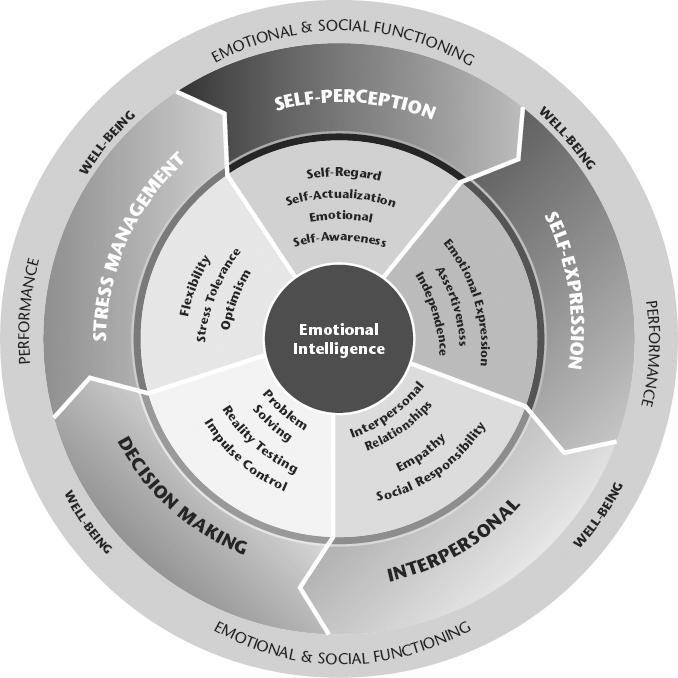
Self-Expression
- Emotional Expression
- Assertiveness
- Independence
Interpersonal
- Interpersonal Relations
- Empathy
- Social Responsibility
Decision Making
- Problem Solving
- Reality Testing
- Impulse Control
Stress Management
- Flexibility
- Stress Tolerance
- Optimism
Happiness/Well-Being
Each individual who completes the measure receives a report showing how strong his or her scores are in each of the subscales and usually receives a debriefing with someone who is certified to administer the measure. A skilled interpreter of the EQ-i2.0 and EQ360 helps the client understand the relative meaning of each score, as well as providing insight into the relationships between the scores. For instance, it might turn out that a person with a very high score in reality testing and a significantly low score in optimism might want to explore how his or her perspective on life might change if he or she did not automatically devote so much attention to making critical evaluations. Might the person feel more optimistic? Similarly, can you imagine what might happen if someone is high in assertiveness and low in impulse control?
The Self-Perception composite includes the following subscales: Self-Regard, Self-Actualization, and Emotional Self-Awareness. These are the capabilities that are necessary to develop, maintain, and understand one’s self effectively.
The Self-Expression composite includes Emotional Expression, Assertiveness, and Independence, all of which contribute to the ability to express one’s self so that others have better understanding and will facilitate interaction.
The Interpersonal scale looks at how effectively we interface and engage within the social milieu. It is composed of Interpersonal Relationships, Empathy, and Social Responsibility.
The Decision Making composite includes Problem Solving, Reality Testing, and Impulse Control. These help us integrate our emotional responses and awareness with the ways we engage and make decisions.
The Stress Management scale measures how well we feel we do at coping with the tension, disappointment, and pain that come from living in a less-than-perfect world. It is that discrepancy between what we desire and what we are able to obtain that constitutes the essence of stress. Stress Management includes Flexibility, Stress Tolerance, and Optimism. Optimism shows us how hopeful we are about the quality of the future we expect, and Flexibility and Stress Tolerance help us act in accord with our hopefulness.
Happiness/Well-Being, which is listed as a separate piece of information, shows how satisfied we feel in the present moment and is tied to the relevant skills of Self-Regard, Optimism, Interpersonal Relationships, and Self-Actualization as these particularly influence our experience of being happy.
Our descriptions of these skills are merely summaries; we suggest you refer to The EQ Edge (Stein & Book, 2011) and the reports themselves for more detailed information. The elegance of the EQ-i2.0 and EQ360 is that the simple, straightforward presentation belies the rigor of its design. Developmental strategies for improving results are included in the individual report. After six months, the assessment can be retaken to assess progress in specific areas and the overall development of emotional intelligence.
TEAM EMOTIONAL AND SOCIAL INTELLIGENCE SURVEY® (TESI®)
The Team Emotional and Social Intelligence (TESI) assessment, developed in 2006 by Marcia Hughes and James Terrell, identifies and measures seven competencies most critical for effective team functioning: Team Identity, Motivation, Emotional Awareness, Communication, Stress Tolerance, Conflict Resolution, and Positive Mood. It also specifies the four results that teams will enjoy as they build these competencies—Empathy, Trust, Loyalty, and Better Decisions—which lead to the two benefits of long-term success, Sustainable Productivity and Emotional and Social Well-Being for the team (Hughes & Terrell, 2007, 2009).
Each of the seven skills for team success influences the others; skills in one area flow into and build an influence in each of the others. In addition, synergistic results are achieved when a team strengthens competencies in most or all of these core areas. Their success becomes greater than the simple combination of each independent skill, building what Hughes and Terrell term Collaborative Intelligence™ (Hughes & Terrell, 2009).
There are two assessment formats available. The TESI Short is an abbreviated, twenty-one-item version of this assessment and is published by Pfeiffer. The short version works well when teams want to take a quick look at their functioning. It’s available in a self-scoring format that creates the flexibility of not having to administer it in advance of a team engagement or workshop. A longer version of the TESI with demographic and other breakouts is available from Collaborative Growth®. Each team member is asked to rate the team’s skills—from his or her individual perspective—in the seven team behaviors of success. An individual report is created, as well as a full team report and many optional demographic reports can be assessed. This serves to create a team 360-degree assessment of all team members’ views on team functioning. From this report, participants better understand the team’s functioning and take steps to build upon their strengths and develop areas needing enhancement. More information about each of the skills is provided in Part Two of this book. In addition, the TESI Facilitator’s Guide (Hughes & Terrell, 2009) is a valuable resource for more information on this assessment.
The Mayer-Salovey-Caruso Emotional Intelligence Test, known as the MSCEIT (mes-keet), is unique in that it undertakes to measure actual intelligence rather than the behavioral competencies and social skills that are associated with individual workplace success. The authors define emotional intelligence as the “ability to perceive emotions, to access and generate emotions so as to assist thought, to understand emotions and emotional knowledge, and to regulate emotions so as to promote emotional and intellectual growth” (Mayer, Salovey, & Caruso, 2002, p. 17). Their test is designed as an ability measure with objective “right and wrong” answers, in contrast with the more subjective competency measures that rely on self-report.
Some examples of the abilities that the MSCEIT undertakes to measure include the ability to label emotions and understand the relationships between words and feelings, the ability to distinguish between authentic emotional expressions and those that are inauthentic or feigned, and the ability to manage emotions by strengthening positive ones and reducing negative ones. Although not all the abilities they seek to measure correspond with specific emotional skills, one can easily see that those listed above have significant correlations with such competencies as emotional self-awareness, empathy, optimism, and impulse control.
As shown in Figure 1.2.1, the authors group these abilities in a 1 – 2 – 4 – 8 hierarchy so the individual taking the test receives fifteen different scores in the report. The first score is a total emotional intelligence score and is composed of two area scores for Experiential and Strategic emotional intelligence. Experiential refers to the basic human ability to respond emotionally—feeling, processing, recognizing, and classifying emotions. Strategic refers to the higher-level, more conscious processing of emotions, reasoning about them, understanding how they originate and develop over time, and how human beings can manage them to enhance social relationships.
Figure 1.2.3. Abilities Hierarchy
Source: MSCEIT™ User’s Manual, page 8. Copyright © 2002 Multi-Health Systems Inc. All rights reserved. 3770 Victoria Park Ave., Toronto, ON M2H 3M6. Reproduced with permission.
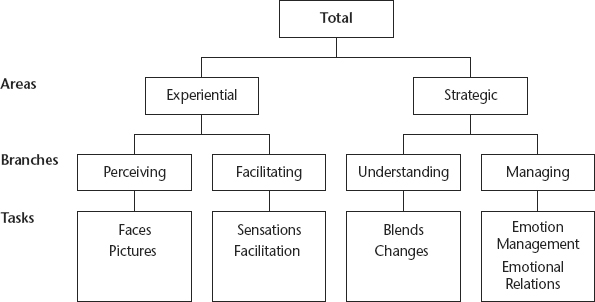
Each of the area scores is composed of two branch scores. Experiential includes the scores of Perceiving Emotion and Facilitating Thought. Perceiving Emotion measures the ability to recognize what you and others are feeling. This entails accurately detecting, decoding, and responding to the emotional signals of our own internal states, as well as our nonverbal communication, most of which is unconscious. Facilitating Thought is the ability to engage the feeling content of our experience on behalf of improved reasoning, decision making, and problem solving. This is the ability to emotionally activate cognitive processes and creatively utilize the variety of viewpoints that we experience as our moods change.
The Strategic score is also composed of two branch scores, Understanding Emotion and Managing Emotions. Understanding Emotion measures the ability to label emotions appropriately and reason with them in an understandable and effective manner. This includes our ability to recognize how our emotions combine and change over time and how well we are able to symbolically represent this complex process. Managing Emotions is the ability to remain open to emotional information when it will enhance our experience and the ability to limit and control that information when it might cause us to react impulsively. Managing emotions is the ability to appropriately balance their significance in our intellectual outlook and behavior, our general ability to cope with life in an emotionally effective manner.
Each of these four branch scores is composed of two task scores that measure eight specific emotional intelligence abilities, such as reading emotion accurately in faces and pictures, understanding how basic emotions combine to produce more complex feelings, and understanding the sequence that emotions go through as they change from one to another. These scores are to be used more hypothetically than predicatively (that is, for developmental suggestions), inasmuch as the reliability for some of the eight task scores is lower than that of the composite scores to which they give rise (Mayer, Salovey, & Caruso, 2002).
EMOTIONAL INTELLIGENCE SKILLS ASSESSMENT
The Emotional Intelligence Skills Assessment (EISA), developed by Steven Stein, Derek Mann, and Peter Papadogiannis (2009), identifies and measures five core factors of emotional intelligence in adults: Perceiving, Managing, Decision Making, Achieving, and Influencing. While all five factors are important, the first two—Perceiving and Managing—are considered foundational to emotional intelligence, as without the ability to accurately perceive and manage one’s own emotions, it is more difficult to respond appropriately to situations requiring effective Decision Making, Achieving, and Influencing.
Figure 1.2.4. EISA Model
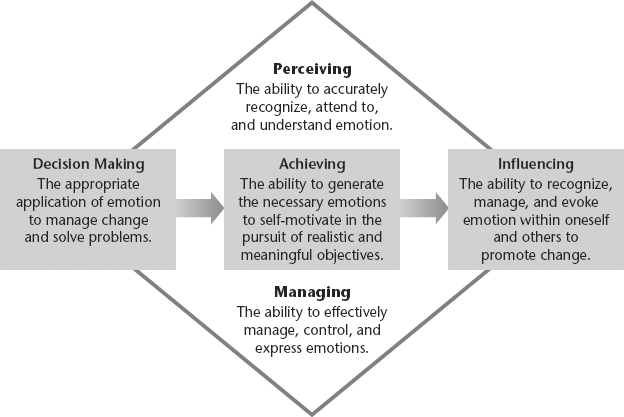
The EISA asks each individual to respond to fifty emotional and behavioral statements; both self and 360 versions of the assessment are available. Individuals receive detailed information about each of the five factors and an indication of their areas of emotional strength and opportunities for growth. Respondents are also encouraged to create a plan that will help them further develop those emotional and social skills needed for improved success.
More information about each of the five factors, Perceiving, Managing, Decision Making, Achieving, and Influencing, is provided in Part Two of this book. In addition, the EISA Facilitator’s Guide (Stein, Mann, & Papadogiannis, 2010) is a valuable resource for more information on this assessment.
The following matrix has been designed for easily cross-referencing the exercises found in Part Three of this book to the relevant content areas for each of the four assessments.
Table 1.2.1. Cross-Reference Matrix
